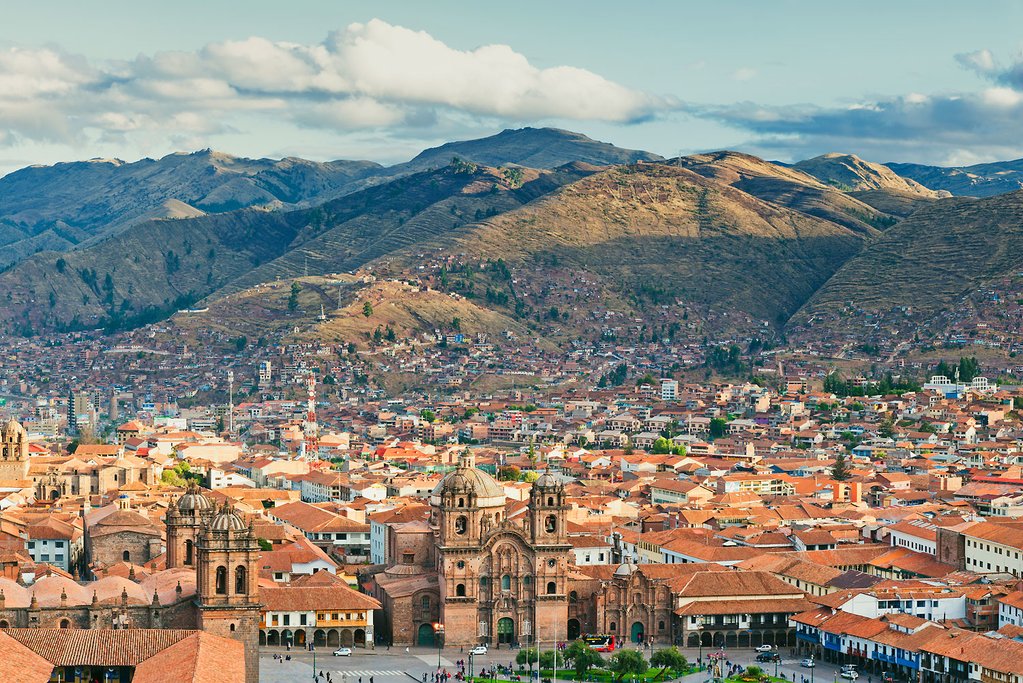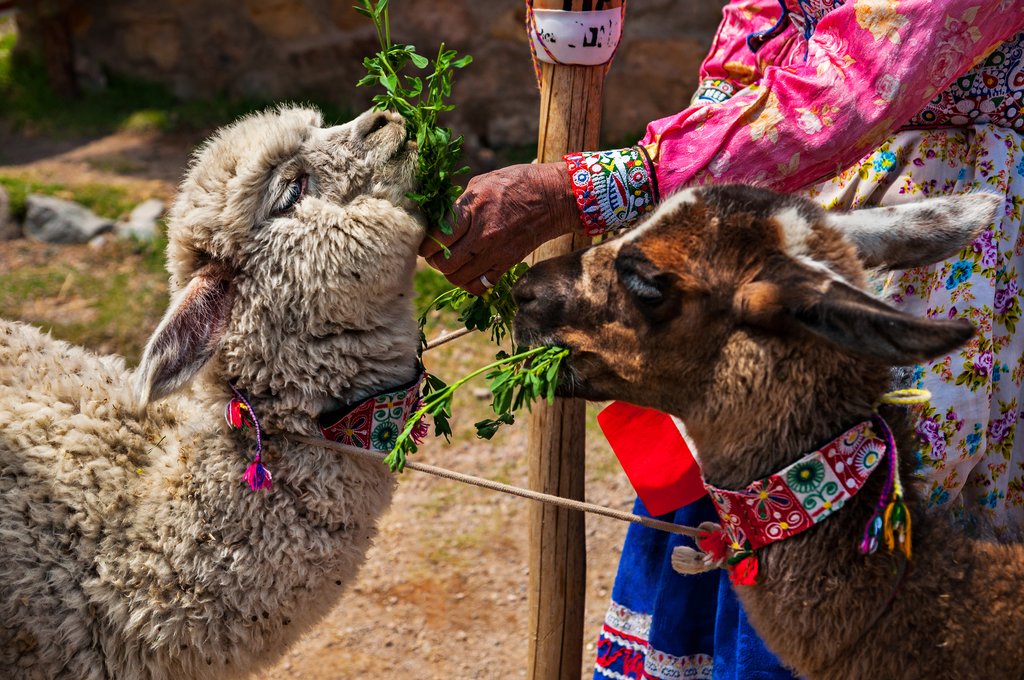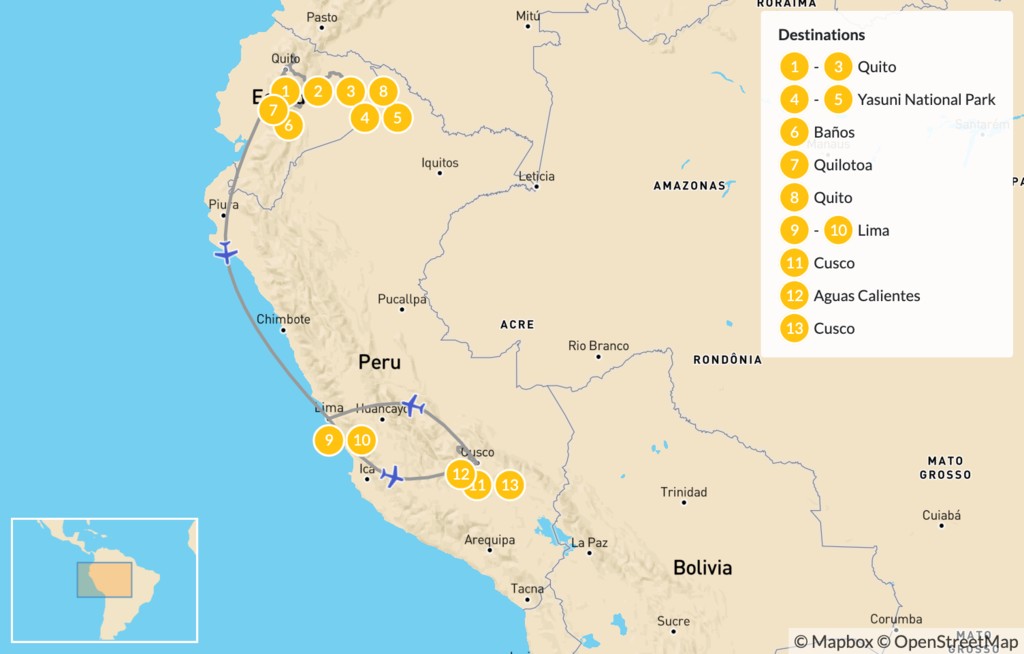Highlights
- Hike at the base of Cotopaxi Volcano
- Haggle for handmade goods at Otavalo Indigenous Market
- Look for wildlife and visit the Kichwa community in the Amazon
- Visit the famed Machu Picchu citadel
- Explore pre-Inca & Inca ruins in Cusco
Brief Itinerary
| Day | Highlights | Overnight |
|---|---|---|
| Day 1 | Arrival to Quito | Quito |
| Day 2 | Quito Historic Center, Panecillo Hill, & Middle of the World Tour | Quito |
| Day 3 | Otavalo Day Trip from Quito | Quito |
| Day 4 | Quito to Yacuma Ecolodge in Yasuni National Park | Yasuni National Park |
| Day 5 | Yacuma Ecolodge: Tubing, Bat Cave, & Kichwa Community | Yasuni National Park |
| Day 6 | Yacuma to Baños | Baños |
| Day 7 | Waterfall Route, Casa de Arbol, & Quilotoa Lagoon | Quilotoa |
| Day 8 | Cotopaxi National Park en Route from Quilotoa to Quito | Quito |
| Day 9 | Flight from Quito to Lima | Lima |
| Day 10 | Lima History Tour | Lima |
| Day 11 | Arrival in Cusco | Cusco |
| Day 12 | Sacred Valley Tour: Cusco - Pisac - Ollantaytambo - Aguas Calientes | Aguas Calientes |
| Day 13 | Machu Picchu Excursion from Aguas Calientes | Cusco |
| Day 14 | Fly from Cusco to Lima, Depart Peru |
Detailed Itinerary
Day 1: Arrival to Quito

Welcome to Quito, the capital of Ecuador! Arrive at the Mariscal Sucre International Airport (UIO), where your driver will meet you to transfer to your accommodation in the city center, a one-hour trip. Along the way, you'll get a short introduction into Quito´s history and a quick briefing on the next day's activities.
The entire city of Quito is a UNESCO World Heritage Site, standing at an altitude of 9,350ft (2,850m). It welcomes visitors with its picturesque plazas situated between mountain peaks. The city has an abundance of market stands, shamanistic healers, and fourth-generation hat makers, as well as a vibrant and sophisticated culinary and nightlife scene.
Day 2: Quito Historic Center, Panecillo Hill, & Middle of the World Tour

The human occupation of Quito dates back thousands of years. Prior to the arrival of Spanish conquistadores, the main cultures in the area were the Quitus, as well as the Inca, whose empire spread across vast stretches of South America. The city was colonized by the Spanish and recognized as a city in the mid-16th century. In 1978, together with Kraków in Poland, the entire city became the first UNESCO World Heritage Site.
After breakfast at the hotel, visit the old town and meander down romantic narrow streets to see the colonial Churches of San Fransisco, La Compañia, and other historical landmarks.
This visit is followed by a short stop at the top of El Panecillo Hill where the impressive statue of the Virgin Mary is located. It's a great place for photos of panoramic city views.
In the afternoon, visit the Equator Monument, which highlights the exact location of the equatorial line according to the Franco-Spanish mission that determined its approximate location. It's also the location of the Ethnographical Museum that showcases the indigenous culture and ethnography of Ecuador.
After a full day, return to your hotel.
Day 3: Otavalo Day Trip from Quito

Today, you'll leave Quito behind as you drive north to the city of Cayambe to try its famous biscochos biscuits. Then, you'll continue to Otavalo, whose famous indigenous market is considered one of the biggest and most colorful in South America. Sharpen your bargaining skills and shop for local crafts.
Your next destination is the beautiful Cuicocha Lake, and the nearby town of Cotacachi, which is renowned for its quality leather goods. Finally, you'll visit the village of Peguche, where you will meet members of the Otavalo indigenous people and learn about the local culture.
Enjoy a free evening back in Quito.
Day 4: Quito to Yacuma Ecolodge in Yasuni National Park

Start your day with a 4-hour transfer to the town of Tena, which sits on the edge of Yasuni National Park. From here, take a motorized canoe to reach the lodge. You'll be welcome with a refreshing Guayusa, a drink which locals drink at dawn as a natural energizer for the remainder of the day.
Settle into your hotel, relax, and spend some time unwinding after the trip. Later, head to the river to try your hand at piranha fishing.
Afterward, return to the lodge for dinner. In the evening, head out for a nighttime wildlife walk, or opt to stay at the lodge and relax.
Day 5: Yacuma Ecolodge: Tubing, Bat Cave, & Kichwa Community

After breakfast, head out for a 3-4 hour hike. You'll get to see and learn about medicinal plants that local communities have used for centuries. The hike eventually winds towards the Bat Cave, parts of which remain unexplored. Inside the cave, you can see bats, spiders, snakes, and other dark-loving creatures. It's also a key site for the nearby community: local Shamans use this cave to gain energy for their rituals.
After the hike, return to the lodge for lunch. In the afternoon, go tubing on the Napo River, where you'll learn about traditional gold panning (a practice that's observed by several of the local communities). This gold is later sold in town.
Afterward, visit a local indigenous Kichwa family, where you'll learn about their culture and lifestyles. You'll also get a demonstration on the process of making and painting ceramics, which the family sells to visitors along with other items of art and crafts.
Return to the lodge for dinner, then learn to make chocolate from locally-grown cocoa beans for a sweet dessert.
In the evening, gather together for one last dinner and a farewell campfire.
Chat with a local specialist who can help organize your trip.
Day 6: Yacuma to Baños

For those interested in bird-watching, an early hike can be arranged this morning to Yacuma's parrot clay-click or to a nearby viewpoint. Return to the lodge for breakfast at 8:00 AM, then make your way to Santa Rosa by motorized canoe.
From here, head to Baños and spend the afternoon soaking in hot springs and exploring the city.
Day 7: Waterfall Route, Casa de Arbol, & Quilotoa Lagoon

In the morning, drive along the Avenue of Waterfalls, a stretch of cascading waterfalls. Driving south from Baños, you'll follow the Pastaza Riveras it winds through the valley of the same name. You'll see the views from the road and the sky as you take a cable car ride over the treetops.
Afterward, hit the road towards Quilotoa Lagoon. En route, visit the famous Casa del Arbol (treehouse) to enjoy views of Baños, before heading to Quilotoa for the night.
Day 8: Cotopaxi National Park en Route from Quilotoa to Quito

After breakfast, meet your private transfer and start heading north towards Quito. Along the way, you'll make a stop at Cotopaxi National Park, whose highlight is the active Cotopaxi Volcano, the only snowcapped volcano in Ecuador. It's in constant slow eruption, giving it a primordial feel.
Enjoy an easy afternoon hike around Limpiopungo Lagoon, learn about the flora and fauna of the Andes mountains and take in the views of Cotopaxi.
After your hike, continue to Quito, arriving in time for dinner.
Day 9: Flight from Quito to Lima

In the morning, head to the airport for your flight to Lima, Peru's largest city and central metropolitan hub, and home to a third of the country's population. Located at the site of a pre-Columbian indigenous Ychsma settlement, which was conquered by the Inca empire in the 15th century and later by the Spanish conquistadores, Lima has a fascinating history and a diverse mix of cultures. Amerindian, European, Afro-Peruvian, and Asian—especially Chinese and Japanese—influences make Lima a dynamic and exciting city to explore.
Lima's breezy location on the Pacific Ocean and mild desert climate make it the perfect city for exploring on foot. Head downtown to mingle with locals, stretch your legs, and grab a bite to eat in one of the city's many award-winning restaurants.
Suggested activities include:
- Visit the Casa Aliaga, a colonial mansion granted by chief conquistador Francisco Pizarro to Jerónimo de Aliaga, one of his captains, in 1535. This is the only house from that era that still belongs to the same family.
- Stroll around the Pueblo Libre district to the privately owned Larco Museum of pre-Columbian art, housed in a beautifully restored viceregal mansion built over a 7th-century pre-Columbian pyramid. The museum boasts a vast pre-Colonial collection of gold and silver artifacts.
- In the evening, head to the eclectic "Love Park" in the upscale coastal district of Miraflores, where you can admire a huge kissing statue and beautiful mosaic walls. The park is built on the cliffs of Chorrillos and is a perfect place to enjoy a spectacular sunset over the Pacific.
- Enjoy a nightcap at an open-air cafe or restaurant in the diverse Miraflores neighborhood.
Day 10: Lima History Tour

Spend today discovering the cultural and historic center of Lima. Explore the historic center of Lima, a UNESCO World Heritage Site packed with fascinating Spanish architecture. Start with a scenic tour of the colonial downtown, which emanates from the main square. Stroll over to the 16th-century Cathedral, which took 80 years to construct and was built in the grandiose style of the Spanish Empire.
Suggested activities include:
- Visit the Casa Aliaga, a colonial mansion granted by chief conquistador Francisco Pizarro to Jerónimo de Aliaga, one of his captains, in 1535. This is the only house from that era that still belongs to the same family.
- Stroll around the Pueblo Libre district to the privately owned Larco Museum of pre-Columbian art, housed in a beautifully restored viceregal mansion built over a 7th-century pre-Columbian pyramid. The museum boasts a vast pre-Colonial collection of gold and silver artifacts, as well as pieces of erotic art.
Day 11: Arrival in Cusco

Head to the Lima airport for your transfer flight to Cusco. After settling in, head out for your day tour of the former capital of the Inca empire, which reigned from the 13th to 16th centuries after conquering the Killke settlement on the same location.
Remember: you will be 11,000 feet (3,000 m) above sea level, so take it easy and remember to drink lots of water. Since Cusco was designed by the Incas as a city for walking, start your exploration of the narrow stone alleyways on foot. Take a walk through the plaza — if the weather is beautiful, it's a perfect place to sit on a balcony and have a cup of coca tea while adjusting to the elevation.
Suggested activities include:
- Visit the Coricancha, also known as "The Temple of the Sun." The temple was built by the Incan Emperor Pachacutec (1438 - 1572), and after the arrival of the Spaniards became the basis for the construction of the Santo Domingo Convent.
- Walk to Sacsayhuamán and next-door Quenqo, both archaeological complexes used mostly for religious and agricultural rituals, located 2.5 miles (4 km) from the city of Cusco. Built by the Killke people, Sacsayhuamán is a marvel of ancient architecture, a monolithic fortress built from giant blocks of stone, the origins and assembly of which remain a mystery.
- Discover the elaborate Puca Pucara ruins—an architectural complex of alleged military use with multiple plazas, baths, aqueducts, walls, and towers. It is believed that the entourage of the Incan emperor used it while he stayed at Tambomachay, the elaborate estate and baths nearby.
- Eat lunch at a local Peruvian restaurant and sample local flavors and cooking techniques—crackling pork, pickled vegetables, seasonal flavors, bread baked in earthen ovens, roasted vegetables, and sweet donuts make for a delicious and filling meal.
Day 12: Sacred Valley Tour: Cusco - Pisac - Ollantaytambo - Aguas Calientes

Meet your driver in the morning and head to the Sacred Valley, which contains many historical and archaeological sites, as well as small towns and textile markets.
Your first stop is Pisac, famous for its bustling textile market. The textile artists in this area are renowned for their skill and craftsmanship. From cleaning and harvesting the wool, to creating intricate designs, the level of detail and attention in their work is unparalleled. Select from a wide assortment of colors, styles, and designs for gifts and souvenirs to take home with you.
Stop at Urubamba, the largest town in the Sacred Valley, for a traditional lunch and a quick stop to see the remains of an Inca palace, located within the city.
From here, head to the ancient Incan city of Ollantaytambo. The city's layout, streets, and some homes have been preserved since the time of the Inca empire. Look for single large lintel over a doorway, an indicator of importance which stems from the Inca. Explore the tranquil plaza and surrounding ruins, which offer an unparalleled view into the lives of the Inca.
From Ollantaytambo, board the scenic train to Aguas Calientes, the starting point for many Machu Picchu adventures. Stroll around the small town, grab some lunch, and relax in the healing hot springs. Get a good night's rest—tommorow is a big day!
Day 13: Machu Picchu Excursion from Aguas Calientes

Get an early start to beat the crowds and get the best views of the ancient ruins. From Aguas Calientes, it's an easy 25-minute bus ride up to the Machu Picchu ruins.
This 15th-century Inca citadel is located at 7,970 ft (2,430 m) and is a masterpiece of engineering that served as a sanctuary and retreat for the Incan Emperor Pachacutec and his royal court. Machu Picchu, which means "Old Mountain," is considered a World Heritage Site by UNESCO and is one of the new Seven Wonders of the World.
Built as a seasonal residence for the Inca family, Machu Picchu was rarely home to more than 800 people, and during the royals' absence, a mere 100 servants would remain at the site to maintain the grounds. Machu Picchu was abandoned 100 years after construction and remained largely hidden to the outside world until the early 20th century.
Your guide will lead you around the site and explain the different buildings and curious corners of the building complex. Approximately one-third of the site has been reconstructed into its original structure, giving visitors a sense for the grandeur and artistry of the original citadel.
After the tour, take the bus back to Aguas Calientes and grab lunch in the picturesque town center. Connect to your train to Ollantaytambo and your connecting transfer back to Cusco.
Day 14: Fly from Cusco to Lima, Depart Peru

Today is your last day in Peru! You will be met at your hotel for a transfer to the Cusco Airport, where you will catch your flight back to Lima and then transfer to your international departure. Alternatively, stay and extend your time in Peru — there's so much to see and explore. ¡Buen viaje!


